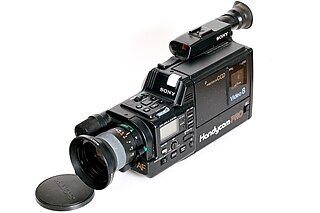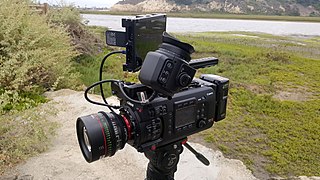The Panavision HD-900F is the first digital high definition camera, able to record using the standard motion picture frame rate of 24 frames per second. It is the result of a collaboration of Panavision and Sony in 1997.
The Panavision HD-900F is the first digital high definition camera, able to record using the standard motion picture frame rate of 24 frames per second. It is the result of a collaboration of Panavision and Sony in 1997.
Panavision and Sony created a new viewfinder, which is entirely redesigned from the old film camera setup, to allow easier controls while filming. The changes were made in order to produce a film friendly system that utilizes many standard camera accessories, such as the follow focus, matte box, heads, etc.
The camera has image quality comparable to industry standards, the lenses utilize state-of-the-art components with the camera itself is still compact and lightweight. The zoom lenses optimize maximum image quality, thus enabling depths of field similar to the 35mm cine formats seen today.
For CGI filmmakers, a pre-filter is used for better color matching and better enhanced resolution for blue screen effects.
The HD-900F High Definition Camera System was first used for a feature film by Jesse Dylan for How High .
Since that time, the HD-900F has been used in:

Digital video is an electronic representation of moving visual images (video) in the form of encoded digital data. This is in contrast to analog video, which represents moving visual images in the form of analog signals. Digital video comprises a series of digital images displayed in rapid succession, usually at 24, 30, or 60 frames per second. Digital video has many advantages such as easy copying, multicasting, sharing and storage.

Widescreen images are displayed within a set of aspect ratios used in film, television and computer screens. In film, a widescreen film is any film image with a width-to-height aspect ratio greater than 4:3 (12:9).

70 mm film is a wide high-resolution film gauge for motion picture photography, with a negative area nearly 3.5 times as large as the standard 35 mm motion picture film format. As used in cameras, the film is 65 mm (2.6 in) wide. For projection, the original 65 mm film is printed on 70 mm (2.8 in) film. The additional 5 mm contains the four magnetic stripes, holding six tracks of stereophonic sound. Although later 70 mm prints use digital sound encoding, the vast majority of existing and surviving 70 mm prints pre-date this technology.

IMAX is a proprietary system of high-resolution cameras, film formats, film projectors, and theaters known for having very large screens with a tall aspect ratio and steep stadium seating, with the 1.43:1 ratio format being available only in few selected locations.

A camcorder is a self-contained portable electronic device with video and recording as its primary function. It is typically equipped with an articulating screen mounted on the left side, a belt to facilitate holding on the right side, hot-swappable battery facing towards the user, hot-swappable recording media, and an internally contained quiet optical zoom lens.

A professional video camera is a high-end device for creating electronic moving images. Originally developed for use in television studios or with outside broadcast trucks, they are now also used for music videos, direct-to-video movies, corporate and educational videos, wedding videos, among other uses. Since the 2000s, most professional video cameras are digital.

HDV is a format for recording of high-definition video on DV videocassette tape. The format was originally developed by JVC and supported by Sony, Canon, and Sharp. The four companies formed the HDV Consortium in September 2003.

A digital single-lens reflex camera is a digital camera that combines the optics and mechanisms of a single-lens reflex camera with a solid-state image sensor and digitally records the images from the sensor.
High-definition video is video of higher resolution and quality than standard-definition. While there is no standardized meaning for high-definition, generally any video image with considerably more than 480 vertical scan lines or 576 vertical lines (Europe) is considered high-definition. 480 scan lines is generally the minimum even though the majority of systems greatly exceed that. Images of standard resolution captured at rates faster than normal, by a high-speed camera may be considered high-definition in some contexts. Some television series shot on high-definition video are made to look as if they have been shot on film, a technique which is often known as filmizing.

Panavision is an American motion picture equipment company founded in 1954 specializing in cameras and lenses, based in Woodland Hills, California. Formed by Robert Gottschalk as a small partnership to create anamorphic projection lenses during the widescreen boom in the 1950s, Panavision expanded its product lines to meet the demands of modern filmmakers. The company introduced its first products in 1954. Originally a provider of CinemaScope accessories, the company's line of anamorphic widescreen lenses soon became the industry leader. In 1972, Panavision helped revolutionize filmmaking with the lightweight Panaflex 35 mm movie camera. The company has introduced other cameras such as the Millennium XL (1999) and the digital video Genesis (2004).
Progressive segmented Frame is a scheme designed to acquire, store, modify, and distribute progressive scan video using interlaced equipment.

CineAlta cameras are a series of professional digital movie cameras produced by Sony that replicate many of the same features of 35mm film motion picture cameras.

Digital cinematography is the process of capturing (recording) a motion picture using digital image sensors rather than through film stock. As digital technology has improved in recent years, this practice has become dominant. Since the mid-2010s, most movies across the world are captured as well as distributed digitally.

The Genesis is a discontinued high-end digital movie camera developed by Panavision, and was available solely by rental. It is based on a proprietary Super 35 1.78:1 (16:9) aspect ratio, 12.4-megapixel, RGB filtered CCD sensor. It was first used by a feature crew to shoot Bryan Singer's Superman Returns, and was shortly followed up thereafter by the World War I film Flyboys. However, the computer effect-heavy nature of these two movies meant that ultimately the comedy Scary Movie 4 was the first theatrically released feature primarily shot with the Genesis. It was discontinued in 2012 and succeeded by the Millennium DXL line developed with Red Digital Cinema.

Ultra Panavision 70 and MGM Camera 65 were, from 1957 to 1966, the marketing brands that identified motion pictures photographed with Panavision's anamorphic movie camera lenses on 65 mm film. Ultra Panavision 70 and MGM Camera 65 were shot at 24 frames per second (fps) using anamorphic camera lenses. Ultra Panavision 70 and MGM Camera 65's anamorphic lenses compressed the image 1.25 times, yielding an extremely wide aspect ratio of 2.76:1.

Sony Corporation produces professional, consumer, and prosumer camcorders such as studio and broadcast, digital cinema cameras, camcorders, pan-tilt-zoom and remote cameras.

Anamorphic format is the cinematography technique of shooting a widescreen picture on standard 35 mm film or other visual recording media with a non-widescreen native aspect ratio. It also refers to the projection format in which a distorted image is "stretched" by an anamorphic projection lens to recreate the original aspect ratio on the viewing screen. The word anamorphic and its derivatives stem from the Greek anamorphoo, compound of morphé with the prefix aná. In the late 1990s and 2000s, anamorphic lost popularity in comparison to "flat" formats such as Super 35 with the advent of digital intermediates; however, in the years since digital cinema cameras and projectors have become commonplace, anamorphic has experienced a considerable resurgence of popularity, due in large part to the higher base ISO sensitivity of digital sensors, which facilitates shooting at smaller apertures.

A digital movie camera for digital cinematography is a video camera that captures footage digitally rather than the historically used movie camera, which shoots on film stock. Different digital movie cameras output a variety of different acquisition formats. Cameras designed for domestic use have also been used for low-budget independent productions.
The Thomson Viper FilmStream Camera is a digital movie camera produced by Thomson Multimedia. Introduced in the early 2000s as makers of feature films were turning to digital cinematography, the Viper influenced subsequent HD, UHD, and HDR cameras.